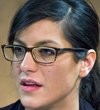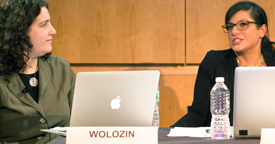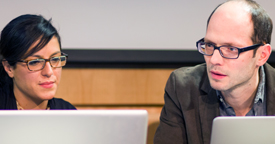| Convergence Journalism? Emerging Documentary and Multimedia Forms of News | ||
| Tuesday, Feb. 19,
2013 Abstract Moderator: Sarah Wolozin, director of the MIT Open Documentary Lab, has produced documentaries and educational media for a variety of media outlets including PBS, History Channel, Learning Channel and NPR. Co-sponsor: MIT OpenDocLab Podcast [this is an edited summary, and not a verbatim transcript] By Katie Edgerton Photos by Greg Peverill-Conti New forms of journalism and documentary story-telling are transforming the online news landscape, said panel moderator Sarah Wolozin, Director of the MIT Open Documentary Lab. What are the central opportunities and challenges facing today's multimedia storytellers? "After working as a filmmaker for about 10 years, I was hired for New York Times in 2011 to be the first video journalist for the opinion pages," said speaker Jason Springarn-Koff, series producer and curator of the Times's Op-Docs initiative. As Springarn-Koff considered how film might become part of the op-ed page, he realized that Op-Docs could become a forum for documentarians to express themselves as print columnists do.
"Op-Docs are short documentaries," explained Springarn-Koff. "I think of them as films, which makes them distinct from journalism." For instance, Op-Doc filmmakers make no claim of journalistic neutrality, approaching their subjects with a distinct point-of-view. The participating filmmakers also have artistic license in terms of their topics and storytelling approaches. According to Springarn-Koff, Op-Docs deployed a range of narrative strategies—the films ranged from interview-driven pieces ("Umbrella Man") to social-issue documentaries ("Dismantling Detriot") to experimental projects ("Solo, Piano - N.Y.C."). "Our mission is to spark public dialogue," said Springarn-Koff. "Filmmakers can use a range of different techniques to start a conversation." Although Op-Docs are distributed online, Springarn-Koff insisted that "we are not producing web videos." Instead, Op-Docs are "short films that live in an online ecosystem." The New York Times website is only one of the many avenues Springarn-Koff and his team use to reach audiences. Op-Docs are available on web video sites Hulu and YouTube, and have screened in movie theaters. Springarn-Koff and his team plan to explore more possible distribution channels in the coming years.
"Working as an online journalist for 8 years, I thought all these changes were happening in a vacuum," said Alexandra Garcia, Multimedia Journalist for the Washington Post and a current Neiman Journalism Fellow at Harvard University. "I didn't realize that people were talking about online journalism outside the news industry." Garcia joined the Post as a photo editor for their website, and gradually began to take on multimedia and video journalism projects. Online video journalism comes out of the tradition of documentary films and photography, said Garcia. "There aren't reporters on screen. We don't do stand-ups like TV broadcast journalism." In that sense, online journalism draws on the legacy of documentary filmmaking in more ways than are often realized or acknowledged. The Washington Post was an early leader in multimedia journalism, said Garcia. The team started to experiment with video on the Post website as early as 1999, and in 2006, a post editor became the first journalist to win an Emmy Award for online work. In 2008, Garcia worked on “The Healing Fields,” a groundbreaking Post interactive site focusing on a free health clinic in southwestern Virginia. The most interesting part of the project, said Garcia, was that the website became a discussion forum. "Dozens of people wrote in to volunteer with the clinic," she said, and many more attended a live online question-and-answer session with the lead reporters and clinic organizers. Garcia realized that the Internet could facilitate greater reader participation and engagement. The Post built on these lessons, launching more interactive sites and soliciting readers' suggestions about what topics they should cover next. Feedback from website visitors helped shape the Post's 2011 interactive series “Under Suspicion: Voices About Muslims in America.” Garcia’s colleagues put out a call on the Post's religion blog that helped shape series; the finished project was a video mosaic of Muslims and non-Muslims asking questions of each other. Visitors could filter the interviews by the respondents' gender, age, religion, and other identifying characteristics--creating a personalized viewing experience. "That series helped us expand into longer-form videos," said Garcia, because it refuted the widespread myth that online videos can’t be longer than a few minutes. Question and Answer "What are the challenges of working with filmmakers and artists in a news context?" asked Wolozin. Do filmmakers have different priorities and objectives than journalists? Jason Springarn-Koff (JSK): We have 30 people on staff doing video, and they are all considered journalists. They pass a certain standard and understand the best practices of journalism. When our staff goes out and do a story, we have total confidence the story will hold to journalistic standards. On the other hand, most filmmakers don't consider themselves journalists. So part of the challenge at the Times is to take our opinion journalism and apply the same rigor you would to any other piece of news. There isn't a contradiction between journalism and opinion, but we do need to fact check and make sure that everything we're presenting is true. Alexandra Garcia (AG): One thing that's often difficult is that people have a set idea of what a newspaper is, and what its staff does. When I show up to an interview with a camera and microphone, it goes against most people’s expectations. Also, visiting the Post website also cuts against expectations. When people want to learn about a particular topic through video, a newspaper's website might not be the first resource that occurs to them. Has there been a shift within newspapers to think about engaging online audiences through multimedia and interactivity? Wolozin asked.
AG: Yes, and definitions of multimedia are changing to encompass more interactivity. The Post used to have a multimedia team, and they often paired photographs with audio interviews to create photo slideshows. Today, multimedia doesn't just mean photo slideshows. Now, almost everything published online involves multiple types of media-- video, written articles, audio, and interactive projects. Furthermore, we are not just trying to engage audiences in the comment section. We want people to be active participants in deciding what kind of viewing experience they want to have. JSK: The New York Times no longer has a multimedia division. We have an interactive graphics department. The people that staff it are programmer-journalists, or designer-journalists. Right now, we're working on the first interactive Op-Docs project. That being said, there isn't any singular future that we're heading towards. Interactive projects, films, all of these media forms showcase different types of stories. Our starting point is almost always to ask what is the best way to tell a particular story, and stay true to that. Sometimes a linear video is best. But other times, there are complex issues and multiple story lines, and those kinds of narratives can benefit from an interactive treatment. The New York Times's recent project “Snow Fall” points the way towards a satisfying user experience and a new type of reading—incorporating text, video, photographs, and interactive elements into a singular article. The team that created it worked hard to integrate different types of media into a seamless, simple reading experience, and the project has been heralded as a great leap forward in interactive storytelling. An audience member asked about the editorial process. “How do you decide what to do?” he said. Is multimedia journalism systematic? Do reporters or filmmakers have a “beat,” or do they vary their topics? JSK: Op-Docs borrows its editorial process from the print op-ed page. We take open submissions, and solicit work from filmmakers. Sometimes, we ask people to make short versions of feature films they might be working on. There’s no beat, per say, but there is a deep knowledge within the paper of many subject areas, and documentarians working on a particular subject for years bring a lot of insight to their particular topic. We don't often do series—we did a four-parter during the elections titled “Electoral Dysfunction,” and there is interest in doing more series, but we're still experimenting. “Do you think online video creates a fragmented viewing experience?” asked an audience member. Today, mobile applications like Vine are encouraging people to create shorter and shorter videos—some capped at 6 seconds. Is there a need to go back to longer, more meaningful videos? AG: I think it depends on the story. I'm struggling with the idea of whether a passive viewing experience where you're led along a particular story line, or an active one is more successful, and I think it depends on the project. I get lost in some interactive projects, while I think others are fantastic. Regardless, we should experiment—new technologies present opportunities that we shouldn’t ignore. Newspaper op-eds are usually written by content experts, said an audience member. But filmmakers are experts in the storytelling form, and might not know as much about particular issues. Do filmmakers’ different expertise change the genre of the opinion piece in a fundamental way? JSK: Filmmakers are often content experts. They routinely work on projects for three to five years and have access to material that news crews who parachute in for a day or two can’t get. Filmmakers bring a richness and sophistication to particular topics that a typical TV news crew can't, for instance. “What is the future of multimedia journalism?” asked an audience member. How do you plan to scale these interactive projects? What is the potential end game? Could video journalism move into the television realm? JSK: Live-ness is essential to TV. Certain broadcast events, like sports games and awards shows, depend on everyone being able to watch them at the same time. The New York Times is now creating streaming video news reports, as is the Washington Post. So one thing newspapers are wrestling with is how much we should be investing in live online broadcast.
AG: In 2012, the Post had a live election-night show. We streamed the Presidential debates and various other content on the Post site. Recently, we had a video run for Valentine's Day about a couple and their love story, and NBC’s Today Show picked it up to rebroadcast. There’s certainly overlap between multimedia journalism and television, but there’s a question of volume. With limited staff and budgets, how much multimedia content can newspapers produce?
| ||




